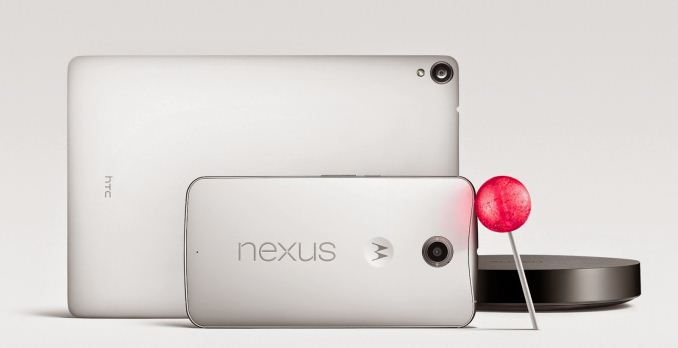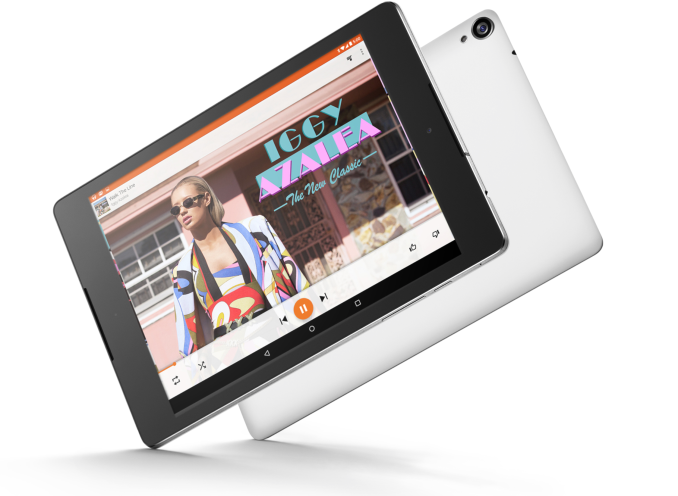Google Announces the Nexus 6 and Nexus 9 Running Android Lollipop
by Brandon Chester on October 15, 2014 12:33 PM EST
Today Google has officially announced the newest devices in the Nexus line, just one day before Apple's October event. Both devices have been rumored for some time now, and this is the first time in a while that we've seen Google introduce a new smartphone and tablet at the same time. The first device in the announcement is the Nexus 6, made by Motorola. The second is the Nexus 9 tablet made by HTC. To give an overview of how both devices look on paper, I've put together their specifications in a chart below.
| Nexus 6 | Nexus 9 | |
| SoC | 2.7GHz Snapdragon 805 (APQ8084) with 4 x Krait 450 + Adreno 420 at 600MHz | 2.3GHz 64-bit dual core Tegra K1 Denver SoC |
| RAM/NAND | 3GB LPDDR3 + 32/64GB NAND | 2GB LPDDR3 + 16/32GB NAND |
| Display | 5.96" 2560x1440 AMOLED | 8.9" 2048x1536 IPS LCD |
| Network | 2G / 3G / 4G LTE | WiFi only or 2G / 3G / 4G LTE SKU |
| Dimensions | 82.98 x 159.26 x 10.06mm, 184g | 153.68 x 228.25 x 7.95mm, 425g WiFi, 436g LTE |
| Camera | 13MP Rear Facing with F/2.0 aperture and OIS, 2MP FFC 4K video recording |
8MP Rear Facing with F/2.4 aperture, 1.6MP FFC |
| Battery | 3220 mAh (12.236 Whr) | 6700 mAh (25.46 Whr) |
| OS | Android 5.0 Lollipop | Android 5.0 Lollipop |
| Connectivity | 802.11a/b/g/n/ac + BT 4.1, USB2.0, GPS/GNSS, NFC | 802.11a/b/g/n/ac + BT 4.1, USB2.0, GPS/GNSS, NFC |
| SIM Size | NanoSIM | NanoSIM on LTE SKU |
 The Nexus 6 features a similar appearance to Motorola's other devices like the Moto X and Moto G. The plastic back is surrounded by a contoured aluminum frame that curves downward at the top where the 3.5mm headphone jack is located. On the back is Google's traditional Nexus logo, accompanied by an indented motorola logo and a centered rear-facing camera. The front is dominated by a large 5.96" display with a pixel density of 493ppi, and stereo speakers on the top and bottom bezels.
The Nexus 6 features a similar appearance to Motorola's other devices like the Moto X and Moto G. The plastic back is surrounded by a contoured aluminum frame that curves downward at the top where the 3.5mm headphone jack is located. On the back is Google's traditional Nexus logo, accompanied by an indented motorola logo and a centered rear-facing camera. The front is dominated by a large 5.96" display with a pixel density of 493ppi, and stereo speakers on the top and bottom bezels.
In terms of its specifications, the Nexus 6 is competitive with all the current Android flagship devices. It packs Qualcomm's latest silicon, a hefty battery, and a high resolution display. However, those premium specs are accompanied by a premium price of $649 outright which is significantly more than the $349 that the Nexus 5 is priced at. The Nexus 5 has been given a new web page along with the other Nexus devices which suggests it isn't going disappear with the launch of this newer, more expensive smartphone.
The next announcement was the Nexus 9 made by HTC. This is the first tablet from HTC since the days of Android Gingerbread and Honeycomb where HTC announced they were exiting the tablet market. With its soft touch back, the Nexus 9 is similar in its design to the Nexus 5. Unlike the Nexus 5 which was an entirely plastic construction, the sides of the Nexus 9 are made of brushed metal.
The front of the device is similar to the Nexus 7 with its asymmetrical bezels. The shape of the device is a departure from any tablet Google has produced before, with a 2048x1536 4:3 display like Apple's iPad. Both the 8.9" display size and 4:3 aspect ratio make the Nexus 9 a significantly larger device than the Nexus 7.
The SoC is the biggest point of interest with the Nexus 9. It will be the first device to ship with Nvidia's Project Denver architecture. This is a custom 64-bit ARMv8 architecture designed by Nvidia, a significant departure from the standard ARM cores used in previous Tegra chips. We covered the details about Tegra K1 Denver previously and you can read that over to get a more in-depth look at NVIDIA's new chip.
Along with the new device announcements comes the official name for the next version of Android. Android L is now Android 5.0 Lollipop, and it will ship on the new Nexus 6 and Nexus 9. Lollipop comes with Google's new Material Design and Google's new ART runtime, and will be rolling out to existing compatible Nexus and Google Play Edition devices in the coming weeks.
The Nexus 9 will be available for pre-order on October 17th starting at $399 for 16GB, while the Nexus 6 will be available sometime in late October at $649 for 32GB.
Source: Google Blog











148 Comments
View All Comments
tuxRoller - Wednesday, October 15, 2014 - link
Which is fantastic for a digital device which only displays PRINTED material...For doing "work" the constraints of printed formats aren't a concern for many professions.
mkozakewich - Wednesday, October 15, 2014 - link
No, 4:3 works better for long-form reading in portrait mode. You could file that under 'legacy', I suppose, because the 8.5x11 paper format is based on dead trees; but it's still better to have more width when working in portrait view.On smartphones, there are more list things. Those work fine with a thinner ratio. I wouldn't be all that surprised if we eventually moved to phones with 64:27 screens and saw more cinematic movie ratios used.
danbob999 - Wednesday, October 15, 2014 - link
Nonsense. We have been working with landscape displays on portrait virtual papers for years without any issue. Ever heard of MS Word?And applications adapt to form factors. Tablet applications would fit widescreen displays better if there were never been any 4:3 tablet.
EnzoFX - Thursday, October 16, 2014 - link
Uhm no. Take webpages, most designers TARGET 4:3 ratios for their webpages, for "desktop" sizes. By your logic we should start using 16:9 printed paper. 4:3 simply translates better to a variety of formats.danbob999 - Thursday, October 16, 2014 - link
Well they are targeting wrong since desktop are no longer 4:3 since the end of CRTs.techconc - Thursday, October 23, 2014 - link
No, phones and tablets really have different use cases. 16x9 works better for a phone not just for movies, but for one handed operation. That's why the iPhone 5 didn't get wider than the 4s, but did get longer.For a tablet, 16:9 is useless for portrait operations. Also, tests show that it's not even great for landscape web browsing due to the browser chrome, etc. 4:3 is best for tablets. Apple was right, Google copied. 16:9 is right for phones. Android was right, Apple copied.
retrospooty - Wednesday, October 15, 2014 - link
Or they could just both be options that people can choose from.danbob999 - Wednesday, October 15, 2014 - link
But that suck for application developers. It's the only reason why the iPad is still 4:3.Ortanon - Wednesday, October 15, 2014 - link
4:3 is better than 16:10 for a tablet. So, that's why the iPad is still 4:3.danbob999 - Wednesday, October 15, 2014 - link
Yeah, that's what they say. 3:2 was also the best smartphone ratio until Apple switched to 16:9.Seriously, why would 4:3 be better for tablets will it suck for everything else, including phones, laptops, desktops, TVs, projectors?